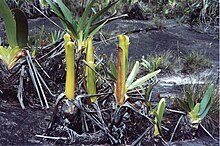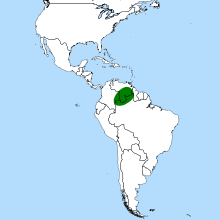Brocchinia reducta
| Brocchinia reducta | |
|---|---|
 |
|
| Brocchinia reducta on Mount Roraima | |
| Scientific classification | |
| Kingdom: | Plantae |
| (unranked): | Angiosperms |
| (unranked): | Monocots |
| (unranked): | Commelinids |
| Order: | Poales |
| Family: | Bromeliaceae |
| Subfamily: | Pitcairnioideae |
| Genus: | Brocchinia |
| Species: | B. reducta |
| Binomial name | |
|
Brocchinia reducta Baker 1882 |
|
 |
|
| Brocchinia reducta distribution | |
Brocchinia reducta /brɒˈkɪniə riːˈdʌktə/ is one of few carnivorous bromeliads. It is native to southern Venezuela, Brazil, Colombia, and Guyana, and is found in nutrient-poor soil.Brocchinia reducta adapts to different environments, growing on rocks and uses its roots as anchors.
Brocchinia reducta, like many other bromeliads, forms a water-storing cup with its tightly-overlapping leaves. The leaves surrounding the cup of B. reducta are coated with loose, waxy scales. These scales are highly reflective of ultraviolet light. Since many insects are attracted to ultraviolet (it is also reflected by many flowers), this is an efficient lure. The water in the cup also emits a sweet odor, which may serve to attract ants and other insects. The brocchinia reducta absorbs its nutrients from the outer cell wall that contain trichomes that transport molecules that are 6.6 nm. (
The scales, being loose, provide a poor foothold for insects landing on them. This allows insects to slip into the water-filled cup and eventually drown.
It has been argued that B. reducta is not actually carnivorous in the sense of other such plants because the production of digestive enzymes could not be found. However, in 2005 it was shown that the plant produces at least phosphatase and thus is a carnivorous plant in sensu stricto. The enzymes and bacteria digest the trapped insects and thus release the nutrients for absorption by the leaves.
...
Wikipedia
